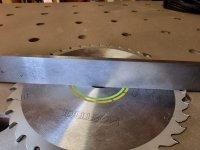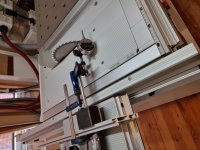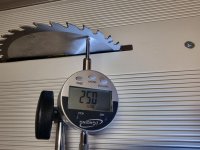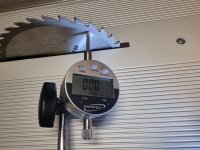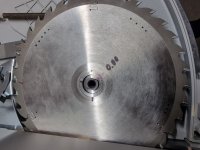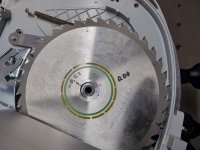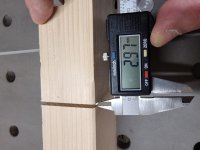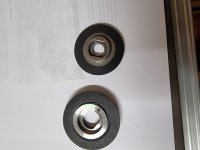arso_bg
Member
- Joined
- Jan 6, 2008
- Messages
- 178
The TS-75 is new to me. I bought it last month with the intention to use it in my CMS-VB.
It is new, not second-hand, with a full Festool guarantee, but there are some issues that bother me.
1. The Festool (492217) Clamping Flange does not fit snugly on the saw spindle but there is a little play. As a result, you can move the saw blade by free hand back and forth about 1.5-2 mm. I wonder what will be the effect of this clearance when cutting with the circular saw.
Also, the riving knife has a play from left to right. Is that normal? Should I bother about this?https://photos.app.goo.gl/tSvKxAAMX5nvRv3F7https://photos.app.goo.gl/4r6Ra5Rm7gm6UcDA8
2. I also tried to find out if the sliding table (Festool 492100) runs parallel to the saw blade. This is why I prepared the setup you can see in Picture 1. I took the first measurement then I turned the saw blade approximately 1/5 turn forward and took the second measurement and so on.
For one full turn of the saw blade, I took 5 times the measurements. The results were surprising and I don't know how to interpret them.
First measurement – 0.00 at the front ; -0.52 mm at the back
Second measurement – 0.00 at the front; -0.22 mm at the back
Third measurement - 0.00 at the front; 0.46 mm at the back
Fourth measurement -0.00 at the front; -1.15 mm at the back
Fifth measurement – 0.00 at the front; -0.97 mm at the back
The saw blade is absolutely flat. You can see this in picture 2. A feeler gauge of 0.02 mm cannot slide between the saw blade and the straight edge.https://photos.app.goo.gl/4gMBe8vrsrxUDgBT6https://photos.app.goo.gl/XwHUWsS9gbQkYmCb9https://photos.app.goo.gl/wuusLSTBfvUheJLr6
What could be the problem? Is there something wrong with my new Festool TS-75?
It is new, not second-hand, with a full Festool guarantee, but there are some issues that bother me.
1. The Festool (492217) Clamping Flange does not fit snugly on the saw spindle but there is a little play. As a result, you can move the saw blade by free hand back and forth about 1.5-2 mm. I wonder what will be the effect of this clearance when cutting with the circular saw.
Also, the riving knife has a play from left to right. Is that normal? Should I bother about this?https://photos.app.goo.gl/tSvKxAAMX5nvRv3F7https://photos.app.goo.gl/4r6Ra5Rm7gm6UcDA8
2. I also tried to find out if the sliding table (Festool 492100) runs parallel to the saw blade. This is why I prepared the setup you can see in Picture 1. I took the first measurement then I turned the saw blade approximately 1/5 turn forward and took the second measurement and so on.
For one full turn of the saw blade, I took 5 times the measurements. The results were surprising and I don't know how to interpret them.
First measurement – 0.00 at the front ; -0.52 mm at the back
Second measurement – 0.00 at the front; -0.22 mm at the back
Third measurement - 0.00 at the front; 0.46 mm at the back
Fourth measurement -0.00 at the front; -1.15 mm at the back
Fifth measurement – 0.00 at the front; -0.97 mm at the back
The saw blade is absolutely flat. You can see this in picture 2. A feeler gauge of 0.02 mm cannot slide between the saw blade and the straight edge.https://photos.app.goo.gl/4gMBe8vrsrxUDgBT6https://photos.app.goo.gl/XwHUWsS9gbQkYmCb9https://photos.app.goo.gl/wuusLSTBfvUheJLr6
What could be the problem? Is there something wrong with my new Festool TS-75?

